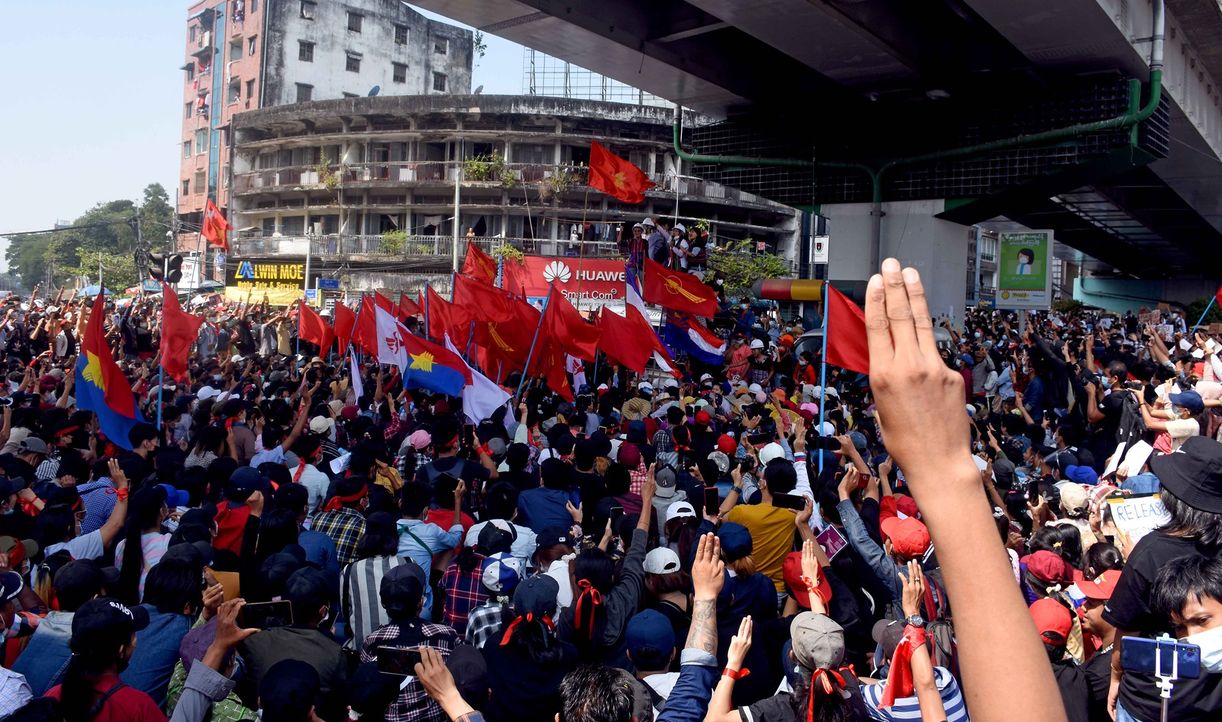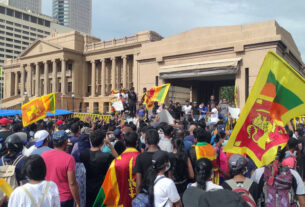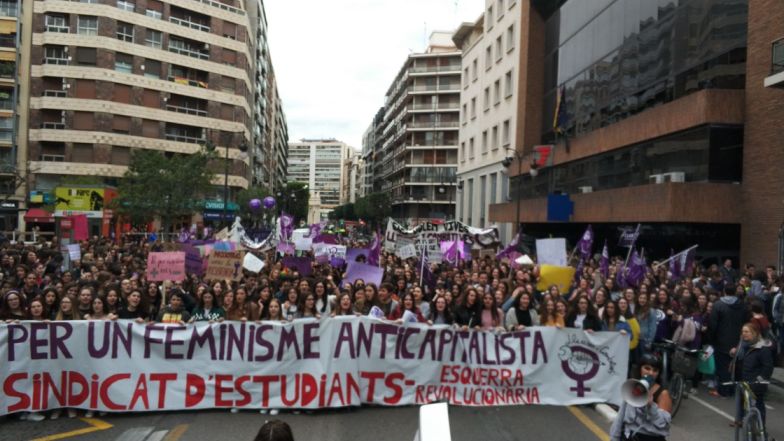Geert Cool is a member of Linkse Socialistiche Partij / Parti Socialiste de Lutte (ISA in Belgium).
After more than two months of massive resistance to the military coup in Myanmar, the junta has not yet been ousted. This raises questions about the way forward, who are reliable allies in the struggle and how the military junta can be overthrown. International Socialist Alternative believes that the heroic masses who have cornered the junta are the force that must finish the job.
All-out offensive by the masses is needed
In recent months, the masses, with the working class at the centre, have shown their determination to break the power of the military leadership. This power is based not just on their control of the political structures, but using the military-controlled companies, also on an economic system which exploits and oppresses working people and the poor.
It is logical now, that in order to protect people from the violence of the army, more effective methods of resistance are being sought, including medical assistance and even arming against the terror of the junta. This logical first step needs to be followed by the coordination of self-defence groups, under the democratic control of those who make the revolution: the workers, the young and the poor. Medics, textile workers, care workers, teachers and many others by taking strike action have ensured that the military leaders did not get away with their coup. They must not allow that the initiative slips out of their hands now. Defence of the movement is not a purely military issue. If this were the case, the army would have crushed the movement from the very beginning. Resistance is continuing because it has broad support in society: that is a political issue.
Strikes have set the tone and point to the important role of the working class in paralyzing the entire system. Intuitively, unity is sought in the fight against the army leadership, including with and by the many minority populations. Yet the power of the army is not yet broken. Repression is spreading, the death toll is rising.
It is impressive that the movement has lasted for more than two months. However, a general offensive based on an all-out general strike and self defence is needed to isolate the junta and to avoid giving the military leadership time to re-organise, so that it can then hit back with even more repression.
Not just military, but a political struggle
Such an all-out offensive requires coordination and a political program that defines the objectives of the movement. To break the might of the army also means reorganizing the country’s economy, as the defense of its own economic interests was one of the major reasons the army launched its coup. This will also demonstrate to ordinary soldiers and their families that the generals are only defending their own interests, making it easier to detach them from the current regime.
A political program of social change must include the complete dismantling of the Tatmadaw (the army), taking the key sectors of the economy into public hands to allow for democratic planning to address the needs of the majority of the population. It should recognise the rights of all minorities to self-determination, including the right to secession. It should reject any interference by foreign governments, each of which defend their own economic interests based on the exploitation of the Myanmar people. This is necessary so that regime change does not just provide a “democratic mask” to even more exploitation, as Orwell described in an 1929 article about what was then colonial Burma.
The masses will not win this revolution by fighting heroically barricade by barricade, but by defending an alternative for the organisation of society. This is how they will be able to respond to all forms of oppression. It is also the way in which the movement will appeal more to ordinary policemen and soldiers who are tired of shooting at their brothers and sisters, but will not cross over to the movement until they see in it the basis for an alternative society.
No trust in any ruling class, locally, regionally or internationally
Many demonstrators hope that the UN will intervene to bring order. The anger against the Chinese regime is reinforced by the fact that it is blocking a stronger UN position. However, the UN is not a “neutral” body, independent from the interests of the various superpowers. This was clear after 2010, when active cooperation with the UN circles led to an opening up to the West. The resulting economic development was accompanied by enormous inequality with elements of mafia capitalism in which both the army and some ethnic armies participated fully.
The changes that followed 2010 were not motivated by the interests of the people, but were intended more to protect at least part of the army leadership from the threat of complete system breakdown, and mass protest that could have put an end to their rule. They were reforms from above to avoid revolution from below.
Ten years on, we see the failure of this policy: the global capitalist economic and health crises have exacerbated existing inequalities and tensions and brought them to a boiling point. Why would the UN do things differently today?
Neither the ruling establishment at home, nor that of other countries can bring real change. Only the masses, with the working class at their centre have the potential power to bring the system to a standstill, but also to take control of society itself, eliminating the profit-seeking of big business, multinationals and mafiosi.
Many protesters are placing great hope in an alternative federal army made up of the forces of the ethnic armies. With over a hundred ethnic minorities and many flashpoints, Myanmar has had elements of civil war for decades. Large parts of the country are not controlled by the official regime. Attempts to reach agreements have worked to a certain extent, particularly when they have been greased by income from trade, official or otherwise. The economic crisis is putting all this under pressure and making previously existing tensions worse.
Many poor people belonging to ethnic minorities support the protests against the military coup. Ethnic minorities leaderships do so too, hoping for a more federal system if the junta is defeated. The National League for Democracy (NLD) of Aung San Suu Kyi, and the NLD-led parallel government CRPH, seem to be responding to this and reaching out to the ethnic armies.
Working class at centre of struggle
It is important that the movement focuses on the working people and the poor to bring about change and mobilises their active support around a program of social change and the right to self-determination. Placing hope in the ethnic armies, or at least in the leaders of those armies, involves great dangers both of an escalation of ethnic violence and civil war and of forms of mafia capitalism. In northern Myanmar, former “communist” rebel groups are already engaged in large-scale drug production and trafficking, the building of casino cities to attract a flood of gambling tourism from China, trade in exotic animals and the particularly lucrative trade in precious stones such as the mineral Jade. This can only be avoided by making sure that any organised self defence is clearly under the democratic control of the working masses and poor.
After two months of mass protest, the cracks in the state apparatus are still relatively small, or at least are not widely known about. It seems that the regime is hoping to strengthen itself by leaning on Russian support to keep the Chinese regime fully on board. The relationship with China is historically strained. This is partly due to Chinese support for groups in northern Myanmar. The blocking of Chinese plans to build the Myitsone Dam in 2011 under Thein Sein hit hard. The decision was partly motivated by fear of protest, and partly by an attempt to balance the influence of the major powers in Myanmar with a greater role for the West.
Current junta leader Min Aung Hlaing was promoted to army chief in 2010 after a military offensive against the Myanmar National Democratic Alliance Army in Kokang, an army of ethnic Han Chinese. Not that this stopped him from negotiating with the Chinese regime immediately afterwards in an attempt to reach an agreement on the Kachin conflict. Under the joint rule of the NLD and the army leadership from 2015, there was a sharp increase in Chinese investment in Myanmar.
For both the Chinese regime and the Myanmar junta, the economic stakes are more important than their different views on the autonomy for ethnic minorities in northern Myanmar. This is shown by the military leadership’s benevolent attitude towards the United Wa State Army, the strongest ethnic militia with 30,000 fighters and Chinese support. It controls part of the drugs trade, and a significant part of domestic air traffic through Yangon Airways. The semi-autonomous Wa is today more closely linked to China’s Yunnan province than to Myanmar itself.
Role of NLD
Min Aung Hlaing has played a key role in blocking the change in the constitution sought by the NLD, which Aung San Suu Kyi (ASSK) needs if she can, as she intends, to become president. This may explain why the NLD is so quick today in demanding the rejection of the existing constitution. However, for real change, it will take more than amending the constitutional rule that prevents ASSK from becoming president.
The main factor in the growing conflict between the NLD and the army leadership in the run-up to the February 1 coup is undoubtedly the struggle for access to lucrative parts of the economy.
In 1988 the NLD was a mass party with rank and file involvement, but not much of that remains today. Although it still maintains strong electoral support, ranging from enthusiasm to a vote against the army, the NLD has become the political expression of those sections of the bourgeoisie and the petty bourgeoisie, who oppose the army leadership or are denied access to those parts of the economy controlled by the military.
The US, Europe and Japan see the NLD as a partner to defend their interests, but don’t hesitate to collaborate with the army too. At the end of March it was revealed that the Dutch pension funds APG and PGGM invested $US 2.3 billion in the military controlled economy.
The Chinese regime does business with both the military and the NLD, but has been suspicious of the “openings” from 2010 onwards that gave the US a greater role and also caused problems such as the suspension of the Myitsone Dam project. For the moment, the Chinese regime undoubtedly wants stability in Myanmar rather than mass protest movements, which could become a source of inspiration for the whole region.
The anti-Chinese sentiment among the population, in protest against Chinese support for the junta at a time when there is a visible Chinese presence in the economy and the country, is exploited to the maximum by the junta to present the movement as a puppet of the US and to push China more strongly into its own camp. It was useful for the regime that there were representatives of US allies such as India and Thailand, alongside Russia and China, at the parade of the “Armed Forces Day.” Playing these regimes off against each other may buy the junta time, but it will not bring stability.
Min Aung Hlaing may hope to return to the pre-2010 situation. However, that is not possible. There was a reason why the regime had to make changes back then: it was either that or collapse in the face of mass protests. An attempt to return to that situation in the context of a new cold war is a very difficult balancing act. The ultimate outcome of this will be determined by the mass protest on the streets.
It is the revolutionary masses that make revolution
The masses in Myanmar have potential allies abroad: working people, the young and the poor who are standing up for their interests and fighting their bosses and governments. Workers in struggle sense this instinctively: the solidarity of activists in the campaign for trade union rights at Amazon in the US was met with solidarity through support by the Burma Federation of Trade Unions. An offensive in Myanmar based on a general strike of indefinite duration should be linked to international solidarity actions from the labour movement. International Socialist Alternative will do all it can to do help this, including through its Facebook page Revolutionary Workers’ Solidarity with Myanmar.
The working class and the poor have nothing to gain from the power struggle of the international powers. It is a struggle over who can exploit the masses of Myanmar the most. Both the NLD and the junta put a lot of their hopes in this power struggle. The masses need an agenda of their own that resists interference by foreign capitalist powers. An independent class position is possible: this has been demonstrated in the last two months by the heroic struggles in the cities and in the countryside.
On the basis of enormous solidarity and determination from below, the movement can win. The increasing repression, especially the terrible death toll on the “Armed Forces Day,” is a warning: the movement must go on the offensive to impose its own agenda. A call for a new general strike of indefinite duration, organised by strike committees that coordinate locally, regionally and nationally and develop a well-defined platform of demands, is how a step forward can be taken.
This can form the basis for a Revolutionary Assembly to organise not just change at the top but a change of the system. The revolution today is made from below, by the working people, the young people and the poor from various ethnic backgrounds. They must determine what society should look like and control all the instruments to do so: from the self-defence of the movement to the control on the natural resources and management of the key sectors of the economy, so that a genuine voluntary federation of peoples and ethnic groups on an equal basis becomes possible.
International Socialist Alternative advocates a socialist society in which the available resources are used democratically in the interests of the majority of the population.




